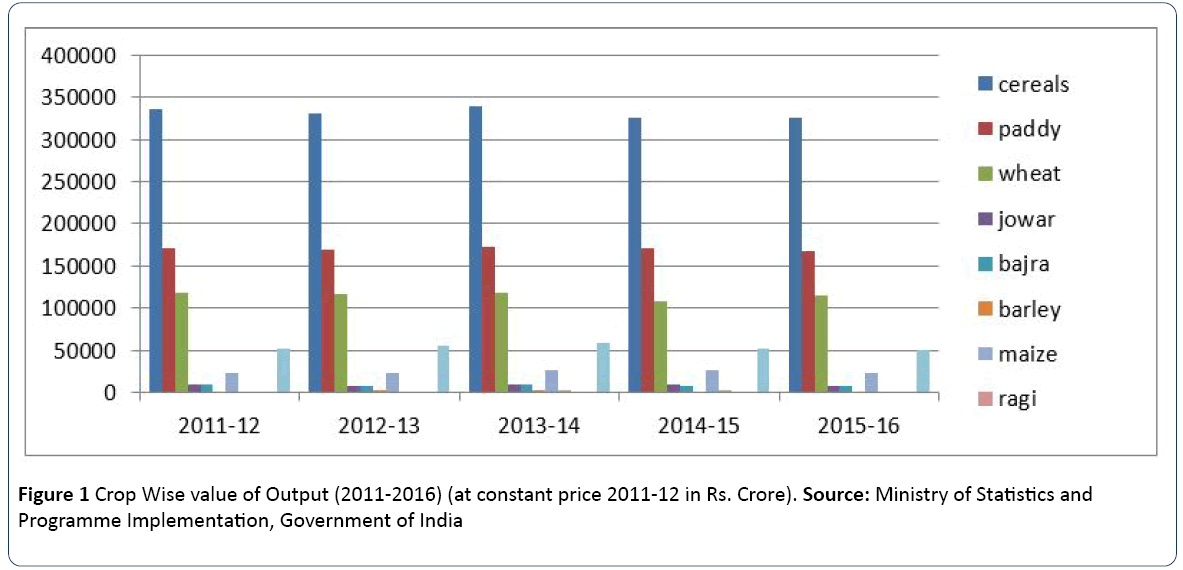Indian Agricultural Scenario in 21st Century
Monarch University, Switzerland
- Corresponding Author:
- Badar Alam Iqbal
Adjunct Professor, Monarch University, Switzerland
E-mail: dr.iqbal@monarch-university.ch
Received date: September 04, 2018; Accepted date: September 20, 2018; Published date: September 28, 2018
Citation: Iqbal BA (2018) Indian Agricultural Scenario in 21st Century. J Food Sci Toxicol. Vol.2 No.1.5
Introduction
Agriculture and allied sectors like forestry and fishing accounted for 17 percent of total Indian Gross Domestic Product and employed about 228.3 million of the country's workforce (NSSO & FICCI, 2015) [1]. Agricultural products which are having significant economic contribution comprises of cereals, paddy, wheat, jowar, maize, etc. (Figure 1).
As per the Second Advance Estimates for 2016–17, the gross value added by agriculture, forestry & fishing in India is estimated to be 1,687,064 crores, recording an increase of 4.4 percent over previous year [2].
State-wise Trends in Agriculture Growth
It is rightly observed that, among the major agricultural states, Gujarat has witnessed the highest growth rate i.e. 8 per cent per year. This is even higher than India’s overall growth rate of 3.3 per cent. The most revealing fact has been that Gujarat contribution in country’s agriculture (Gross Domestic Product) GDP was higher than that attained by State of Punjab during the Green Revolution (1971-85) i.e. 5.7 per cent per annum. The most alarming trend has been that even Uttar Pradesh has registered a growth rate of less than India’s growth rate. The other states like Uttarakhand, Tamil Nadu, Jammu and Kashmir, Odisha have performed better than Uttar Pradesh. The worst is that Punjab has been at the lowest of the ladder recorded just 2 percent.
Production and Exports Trends
The then Prime Minister, Atal Bihari Vajpayee had taken the bold and historic decision regarding commercial use of Bt cotton and that decision has pushed production and exports of cotton on an increasing trend. It is pertinent to point out that decision had benefited the Gujarat most. This could be testified from the fact that 90 per cent increase in the area under cultivation of Bt cotton by the end of 2014. In the year 2000-01 the all India cotton output was 14 million bales and this figure touched upon almost 35 million bales in 2016-17 an increase of more than 2.5 times. Similar trends have been in case of exports of Bt cotton. During the year 2000-01 India’s exports of Bt cotton was US $ 14 million and this figured has touched a level of US $ 1535 million. These trends have made out India as the second biggest producer and exporter of Bt cotton in the world.
Agriculture during UPA vs NDA
Out of the several models of agriculture present, Gujarat model is one of the recent one implemented in the entire country [3]. The model basically argues for the usage of best technologies by the farmers which may give them access to unexplored markets. The may fetch better prices for their crop produce. If the words of agricultural economists are to be accepted, 4 per cent growth rate is required to sustain rural economy in India. This was attained during the (United Progressive Alliance) UPA government in 2013-14. However, the contrast is found in the rule of (National Defence Academy) NDA government with the rate of growth being only 1.8 per cent, a matter of concern for the Indian economy. The Gujarat model has shown tremendous growth at the rate of 8 per cent per annum from 2002-03 to 2013-14, a figure higher than the national growth rate of 3.3 per cent. It is the expectation of economists that Gujarat model will be replicated in other states as well. Moreover, the sad part is that it did not happen in other states due to multitude of reasons. Lack of rainfall was identified as the cause of stunted growth rate of 1.8 per cent during the years 2014-15 and 2015-16. Despite good harvest in 2016-17 fiscal year, farmers suffered losses as the agro prices crashed (NSSO, 2015).
Table 1 India’s Agricultural Growth under UPA and NDA Governments. Source: the Indian Express; New Delhi; October 9, 2017. P. 9
| Period | % Growth rates |
|---|---|
| 2004-05 to 2013-14 (10 Years) UPA | 3.7 |
| 2011-12 to 2013-15 (# years) UPA | 4 |
| 2014-15 to 2016-17 (3 Years) NDA | 1.8 |
Table 1: India’s Agricultural Growth under UPA and NDA Governments. Source: the Indian Express; New Delhi; October 9, 2017. P. 9
Data cited in (Table 1) reveal that India’s agricultural growth was much better during the rule of UPA government in the year 2013-14, the growth rate of Indian agriculture was 4 per cent which India needs to achieve every year to sustain rural India and Indian economy in general. Unfortunately, under the NDA government agricultural growth rate went down considerably and touched a lowest growth rate of 1.8 per cent affecting rural India in big way and Indian economy too.
During the period 2003 and 2014, Gujarat state registered the highest growth rate as high as 8 per cent, followed by Madhya Pradesh, Rajasthan, Jharkhand, Chhattisgarh, Bihar, Maharashtra, Himachal Pradesh, Andhra Pradesh, Karnataka, and Haryana. These states were having higher growth rate as compared to all India growth rate. The remaining sates such as Uttarakhand, Tamil Nadu, Jammu and Kashmir, Uttar Pradesh, Assam, West Bengal, Punjab and Kerala were recorded less than all India growth rate in agriculture. It is being predicted that the estimate for 2017-18 may not be higher and may be around 2 per cent. This will result into keeping more pressure on rural economy and Indian economy journal [4].
To boost agricultural produce, Indian rural sector requires immediate attention and action plan of policy makers and economists, alike. To address the issue pragmatically, government must consider huge investment in irrigation, power, and infrastructure in rural sector. Rural sector will fail to add to the country’s economy in terms of growth and development if higher growth rates are not achieved in agriculture and allied sectors.
References
Open Access Journals
- Aquaculture & Veterinary Science
- Chemistry & Chemical Sciences
- Clinical Sciences
- Engineering
- General Science
- Genetics & Molecular Biology
- Health Care & Nursing
- Immunology & Microbiology
- Materials Science
- Mathematics & Physics
- Medical Sciences
- Neurology & Psychiatry
- Oncology & Cancer Science
- Pharmaceutical Sciences

